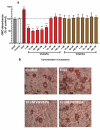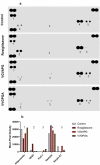Elastin-derived peptide VGVAPG decreases differentiation of mouse embryo fibroblast (3T3-L1) cells into adipocytes
- PMID: 32463311
- PMCID: PMC7469433
- DOI: 10.1080/21623945.2020.1770525
Elastin-derived peptide VGVAPG decreases differentiation of mouse embryo fibroblast (3T3-L1) cells into adipocytes
Abstract
Elastin is a highly elastic protein present in connective tissue. As a result of protease activity, elastin hydrolysis occurs, and during this process, elastin-derived peptides (EDPs) are released. One of the constitutively repeating elastin and EDP building sequences is the hexapeptide VGVAPG. Therefore, the aim of our research was to define the effect of VGVAPG peptide on adipogenesis in a mouse 3T3-L1 cell line. 3T3-L1 cells were differentiated according to a previously described protocol and exposed to increasing concentrations of VGVAPG or VVGPGA peptide. The obtained results showed that VGVAPG peptide does not stimulate reactive oxygen species (ROS) production, caspase-1 activation, and 3T3-L1 cell proliferation. In the second part of the experiments, it was proved that VGVAPG peptide decreased lipid accumulation as measured by oil red O staining, which was confirmed by the profile of increased expression markers of undifferentiated preadipocytes. In our experiments, 10 nM VGVAPG added for differentiating to adipocytes increased the expression of Pref-1, serpin E1, and adiponectin as compared to rosiglitazone (PPARγ agonist)-treated group and simultaneously decreased the expression of VEGF and resistin as compared to the rosiglitazone-treated group. The obtained results show that VGVAPG peptide sustains 3T3 cells in undifferentiated state.
Abbreviations: DMSO: dimethyl sulphoxide; EBP: elastin-binding protein; EDPs: elastin-derived peptides; FBS: foetal bovine serum; Glb1: gene for beta-galactosidase; LDL: low-density-lipoprotein; PAI-1 (Serpin E1): plasminogen activator inhibitor-1; PBS: phosphate-buffered saline; PPARγ: peroxisome proliferator-activated receptor gamma; Pref-1: preadipocyte factor 1; ROS: reactive oxygen species; VEGF-A: vascular endothelial growth factor-A; VGVAPG: Val-Gly-Val-Ala-Pro-Gly; β-Gal: beta-galactosidase; ORO: oil red O; IBMX: 3-isobutyl-1-methylxanthine; H2DCFDA: 2',7'-dichlorodihydrofluorescein diacetate; DMEM: Dulbecco's Modified Eagle's Medium; VVGPGA: Val-Val-Gly-Pro-Gly-Ala.
Keywords: 3T3; VGVAPG; elastin-derived peptides; lipid accumulation.
Conflict of interest statement
The authors declare no conflict of interests.
Figures





Similar articles
-
Elastin-derived peptide VGVAPG affects the proliferation of mouse cortical astrocytes with the involvement of aryl hydrocarbon receptor (Ahr), peroxisome proliferator-activated receptor gamma (Pparγ), and elastin-binding protein (EBP).Cytokine. 2020 Feb;126:154930. doi: 10.1016/j.cyto.2019.154930. Epub 2019 Nov 21. Cytokine. 2020. PMID: 31760184
-
Impact of elastin-derived VGVAPG peptide on bidirectional interaction between peroxisome proliferator-activated receptor gamma (Pparγ) and beta-galactosidase (β-Gal) expression in mouse cortical astrocytes in vitro.Naunyn Schmiedebergs Arch Pharmacol. 2019 Apr;392(4):405-413. doi: 10.1007/s00210-018-1591-4. Epub 2018 Dec 3. Naunyn Schmiedebergs Arch Pharmacol. 2019. PMID: 30511276
-
Calcium channel antagonists interfere with the mechanism of action of elastin-derived peptide VGVAPG in mouse cortical astrocytes in vitro.Neurochem Int. 2022 Oct;159:105405. doi: 10.1016/j.neuint.2022.105405. Epub 2022 Aug 5. Neurochem Int. 2022. PMID: 35934159
-
Specific role of N-methyl-D-aspartate (NMDA) receptor in elastin-derived VGVAPG peptide-dependent calcium homeostasis in mouse cortical astrocytes in vitro.Sci Rep. 2019 Dec 27;9(1):20165. doi: 10.1038/s41598-019-56781-5. Sci Rep. 2019. PMID: 31882909 Free PMC article.
-
Structural characterization of VGVAPG, an elastin-derived peptide.Biopolymers. 2004;76(3):266-80. doi: 10.1002/bip.20029. Biopolymers. 2004. PMID: 15148686 Review.
Cited by
-
Elastin-Derived VGVAPG Fragment Decorated Cell-Penetrating Peptide with Improved Gene Delivery Efficacy.Pharmaceutics. 2023 Feb 16;15(2):670. doi: 10.3390/pharmaceutics15020670. Pharmaceutics. 2023. PMID: 36839992 Free PMC article.
-
Sialic acids cleavage induced by elastin-derived peptides impairs the interaction between insulin and its receptor in adipocytes 3T3-L1.J Physiol Biochem. 2024 May;80(2):363-379. doi: 10.1007/s13105-024-01010-5. Epub 2024 Feb 23. J Physiol Biochem. 2024. PMID: 38393636
-
Immune cell infiltration and the genes associated with ligamentum flavum hypertrophy: Identification and validation.Front Cell Dev Biol. 2022 Aug 10;10:914781. doi: 10.3389/fcell.2022.914781. eCollection 2022. Front Cell Dev Biol. 2022. PMID: 36036007 Free PMC article.
-
Interaction Between Aging-Related Elastin-Derived Peptide (VGVAPG) and Sirtuin 2 and its Impact on Functions of Human Neuron Cells in an In Vitro Model.Mol Neurobiol. 2025 Jan;62(1):819-831. doi: 10.1007/s12035-024-04298-y. Epub 2024 Jun 24. Mol Neurobiol. 2025. PMID: 38914873 Free PMC article.
-
Elastin-Derived Peptides in the Central Nervous System: Friend or Foe.Cell Mol Neurobiol. 2022 Nov;42(8):2473-2487. doi: 10.1007/s10571-021-01140-0. Epub 2021 Aug 10. Cell Mol Neurobiol. 2022. PMID: 34374904 Free PMC article. Review.
References
-
- Li DY, Brooke B, Davis EC, et al. Elastin is an essential determinant of arterial morphogenesis. Nature. 1998;393:276–280. - PubMed
-
- Keith DA, Paz MA, Gallop PM, et al. Histologic and biochemical identification and characterization of an elastin in cartilage. J Histochem Cytochem. 1977;25:1154–1162. - PubMed
-
- Mecham RP, Madaras J, McDonald JA, et al. Elastin production by cultured calf pulmonary artery endothelial cells. J Cell Physiol. 1983;116:282–288. - PubMed
-
- Lin S, Sandig M, Mequanint K.. Three-dimensional topography of synthetic scaffolds induces elastin synthesis by human coronary artery smooth muscle cells. Tissue Eng - Part A. 2011;17:1561–1571. - PubMed
Publication types
MeSH terms
Substances
LinkOut - more resources
Full Text Sources
Research Materials
Miscellaneous
